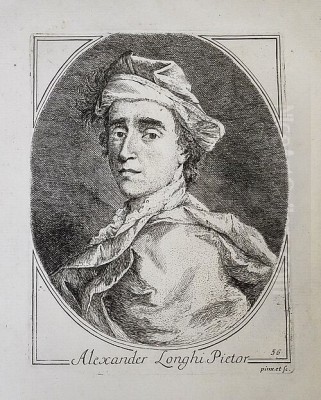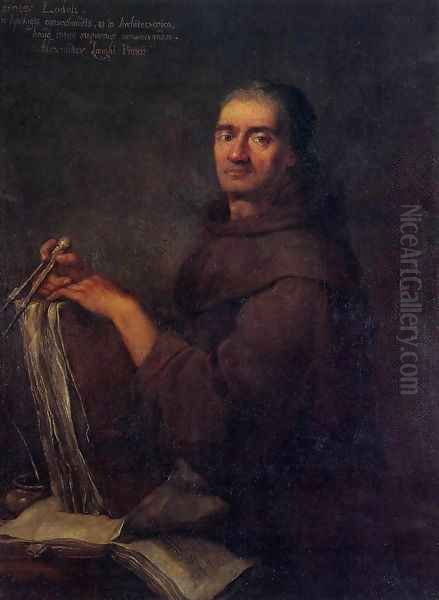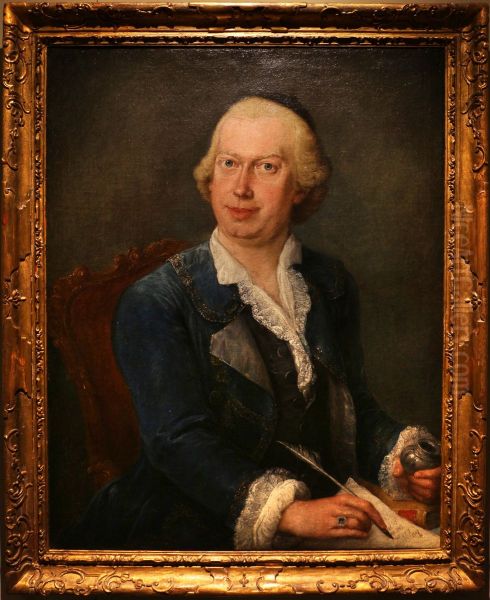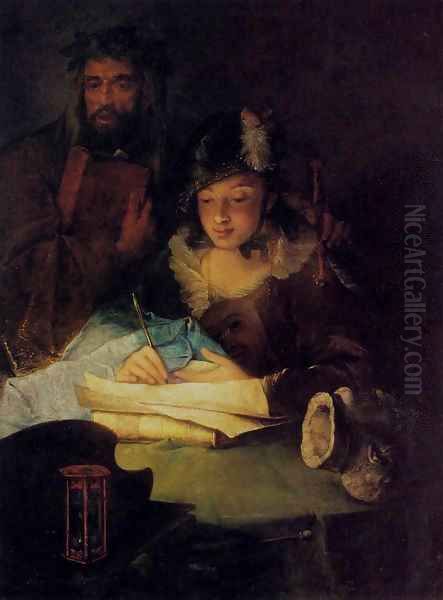
Alessandro Longhi (1733-1813) stands as a significant figure in the twilight years of the Venetian Republic's artistic dominance. Primarily celebrated as a portrait painter, he was also an accomplished printmaker and an early art historian, documenting the lives of his contemporaries. Born into an artistic dynasty, he navigated the shifting tastes of the Settecento, blending Venetian tradition with the pervasive elegance of the Rococo, leaving behind a valuable record of the era's personalities and artistic milieu. His life and work offer a fascinating window into the cultural vibrancy and eventual decline of Venice in the 18th century.
The Venetian Crucible: Art and Society in the Settecento
To understand Alessandro Longhi, one must first appreciate the unique environment of 18th-century Venice. While the Republic's political and economic power was waning, its cultural life remained extraordinarily vibrant. Venice was a city of spectacle, famous for its Carnival, theatres, opera houses, and opulent palazzi. It was a mandatory stop on the Grand Tour, attracting wealthy visitors from across Europe eager to experience its pleasures and commission artworks as souvenirs. This created a fertile ground for artists, fostering a final, brilliant flowering of the Venetian School, known for its rich colour, dynamic compositions, and often theatrical flair, exemplified by masters like Giambattista Tiepolo and Canaletto.
The art market catered to diverse tastes, from the grand historical and mythological ceiling decorations perfected by Tiepolo to the meticulously detailed city views (vedute) of Canaletto and Francesco Guardi, the intimate pastel portraits of Rosalba Carriera, and the charming genre scenes depicting everyday Venetian life, a field dominated by Alessandro's own father, Pietro Longhi. Patronage came from the established nobility, the wealthy merchant class, religious institutions, and the burgeoning tourist market. It was within this complex and dazzling artistic ecosystem that Alessandro Longhi forged his career.
Early Life and Artistic Formation

Alessandro Falca, known as Longhi, was born in Venice in 1733. His artistic education began inevitably under the guidance of his father, Pietro Longhi (1701-1785). Pietro had established himself as a painter of small-scale genre scenes, capturing the intimate, often gently satirical, moments of Venetian domestic life, masquerades, and social gatherings. While Alessandro would ultimately specialize in a different genre – formal portraiture – the influence of his father's keen observation of detail, particularly in costume and setting, remained evident throughout his career.
To refine his skills, particularly in the more formal aspects of portrait painting, Alessandro also studied with Giuseppe Nogari (1699-1763). Nogari was himself a respected portraitist, known for his elegant, slightly idealized depictions, often employing a softer, more pastel-influenced palette reminiscent of the celebrated Rosalba Carriera. This training likely honed Alessandro's ability to capture likenesses while imbuing them with the fashionable grace expected by aristocratic patrons. This dual tutelage provided him with a solid foundation in Venetian artistic traditions combined with the refined techniques necessary for successful portraiture.
The Ascendancy of a Portraitist
While his father Pietro documented the activities of the Venetian elite, Alessandro focused on capturing their personas. He quickly gained recognition for his skill in portraiture, becoming the favoured painter for many members of the Venetian aristocracy. His ability to render not just a physical likeness but also the status and social standing of his sitters, often through meticulous attention to their lavish attire, jewels, and symbolic accoutrements, was highly valued.
In 1759, his growing reputation was solidified by his election to the Venetian Academy of Painting and Sculpture (Accademia di Belle Arti di Venezia). This prestigious institution, which included luminaries like Giambattista Tiepolo and Giambattista Piazzetta among its members at various times, was the centre of artistic life and education in the city. Membership conferred significant status and provided opportunities for commissions and influence. Longhi became an active member, participating in its exhibitions and contributing to its activities for many years.
Artistic Style: Venetian Richness Meets Rococo Grace
Alessandro Longhi's style represents a fascinating confluence of influences. From the broader Venetian tradition, he inherited a love for rich colour, although often applied with more restraint than the exuberant palettes of Tiepolo or Sebastiano Ricci. He also displayed the Venetian sensitivity to the effects of light and shadow, using chiaroscuro not just for dramatic effect but to model form and create a sense of presence, albeit softer than the tenebrism of earlier Baroque masters.

The influence of the French Rococo, which permeated European art in the mid-18th century, is undeniable in Longhi's work. This is visible in the elegance of his poses, the delicate rendering of fabrics like silk and lace, and a certain lightness of touch. While perhaps not as overtly playful or frothy as French exponents like François Boucher or Jean-Honoré Fragonard, Longhi absorbed the Rococo emphasis on refinement and decorative appeal. His attention to the intricate details of costume often rivals that seen in French portraiture of the period.
However, Longhi remained distinctly Venetian. His portraits often possess a solidity and a directness that distinguishes them from some of their French counterparts. There is less idealization than in Nogari's work and a greater focus on capturing the individual character, even if filtered through the conventions of aristocratic representation. He balanced the demand for flattering likenesses with a degree of realistic observation, particularly evident in the faces of his sitters.
Masterpieces of Portraiture
Alessandro Longhi's reputation rests firmly on his portraits. One of his most celebrated works is the Portrait of Carlo Lodoli (c. 1760-1765, Gallerie dell'Accademia, Venice). Lodoli was an influential architectural theorist and Franciscan friar known for his rationalist ideas. Longhi depicts him seated, quill pen in hand, surrounded by books and architectural drawings, conveying his intellectual pursuits. The portrait is notable for its psychological insight and strong characterization, rendered with sober colours and confident brushwork, capturing the sitter's serious and perhaps slightly severe personality.
Another significant work is the Portrait of Giulio Contarini da Mula (c. 1765, Accademia dei Concordi, Rovigo). Often cited as one of his finest achievements, this portrait depicts the Procurator of Saint Mark's (one of the highest offices in the Republic) in his ceremonial robes. Longhi masterfully captures the textures of the velvet and ermine, symbols of Contarini's high status. The sitter's expression is dignified yet approachable, showcasing Longhi's ability to convey both office and personality. The rich reds and golds are handled with typical Venetian flair.
The Portrait of Giuseppe Chiribiri (1779, Ca' Rezzonico, Venice) shows Longhi's continued skill later in his career. Chiribiri, likely a merchant or official, is presented with a direct gaze and a hint of a smile. The painting is characterized by its vibrant colour palette, particularly the sitter's blue coat, and the elegant, relaxed pose. It demonstrates Longhi's consistent ability to create engaging and lifelike portraits that satisfied the social requirements of his clientele while retaining artistic integrity.

His Portrait of Captain Pietro Budinich (1781) commemorates a specific event – the captain's voyage to America. This work highlights Longhi's capacity to incorporate narrative elements and specific details relevant to the sitter's life and achievements, moving slightly beyond pure formal portraiture. The attention to naval details and the confident stance of the captain make it a compelling image of a man of action.
Beyond Portraiture: Allegory and Printmaking
While portraiture was his mainstay, Alessandro Longhi did occasionally venture into other genres. He produced a small number of allegorical paintings, such as Painting and Merit (c. 1761, Gallerie dell'Accademia, Venice), likely painted in connection with his membership in the Academy. These works, though less numerous, demonstrate his competence in handling more complex compositions and symbolic content, aligning with the academic traditions favoured by institutions like the Accademia.
Longhi was also a highly skilled printmaker, primarily working in etching. His graphic work is notable for its technical proficiency and often displays a clear influence from the master etcher, Rembrandt, particularly in the use of light and shadow and the expressive quality of line. His most significant contribution in this medium was intrinsically linked to his work as an art historian.
The Compendio: Chronicler of Venetian Art
In 1762, Alessandro Longhi published his Compendio delle Vite de' Pittori Veneti Istorici piu rinomati del presente secolo con suoi Ritratti tratti dal naturale incisi da Alessandro Longhi (Compendium of the Lives of the Most Renowned Historical Venetian Painters of the Present Century with their Portraits taken from life etched by Alessandro Longhi). This ambitious volume aimed to document the leading Venetian painters of his time, providing biographical sketches and, crucially, engraved portraits of the artists themselves, etched by Longhi based on his own drawings or paintings.
The Compendio is an invaluable resource for art historians studying the Venetian Settecento. It offers contemporary accounts and likenesses of artists like Giambattista Tiepolo, his father Pietro Longhi, Sebastiano Ricci, Giambattista Piazzetta, Rosalba Carriera, Canaletto, and others. While perhaps not possessing the narrative depth or critical insight of Giorgio Vasari's earlier Lives of the Artists, Longhi's work provides a unique snapshot of the Venetian art scene from the perspective of a practicing artist. His own etchings add a personal dimension, preserving the appearances of figures who shaped the final chapter of Venice's artistic glory. The book cemented Longhi's status not just as a painter but as a serious contributor to the history and documentation of Venetian art.
A Circle of Contemporaries: Art and Ideas
Alessandro Longhi operated within a vibrant cultural network. His most immediate artistic connection was, of course, his father, Pietro. While their chosen genres differed, they shared a common milieu and undoubtedly exchanged ideas. His teacher, Giuseppe Nogari, represented the more established, elegant tradition of portraiture. Longhi's work inevitably invites comparison with other leading figures of the Venetian Settecento. His portraits stand in contrast to the grand decorative schemes of Giambattista Tiepolo and his son Giandomenico Tiepolo, the vedute of Canaletto and Francesco Guardi, or the intimate pastels of Rosalba Carriera.
Beyond the visual arts, Longhi moved in circles that included prominent literary figures. He maintained friendships with the playwright Carlo Goldoni and the writer and critic Gaspare Gozzi. Goldoni, famous for reforming Italian comedy by moving away from the stock characters of the Commedia dell'Arte towards more realistic depictions of Venetian life, reportedly admired Longhi's work, calling him a "seeker of truth." This suggests a shared interest in observing and representing contemporary society, albeit through different mediums. Longhi even painted Goldoni, though the playwright apparently disputed the likeness.
His connection with Gozzi, another significant figure in Venetian letters and journalism, further places Longhi within the intellectual currents of the late Enlightenment in Venice. These connections underscore the fact that artists were not isolated figures but active participants in the broader cultural and social life of the city, engaging with writers, musicians (like the earlier Antonio Vivaldi or contemporaries like Baldassare Galuppi), and thinkers who collectively defined the era's unique character. He would also have been aware of major Italian artists working elsewhere, such as the leading portraitist in Rome, Pompeo Batoni, whose style catered heavily to Grand Tour patrons.
Later Years and the Fall of Venice
Alessandro Longhi continued to paint and remain active in the Venetian art world through the latter decades of the 18th century. He witnessed the gradual erosion of the Republic's independence and its final, ignominious fall to Napoleon Bonaparte in 1797. This event marked the end of an era, not just politically but culturally. The patronage systems that had supported artists for centuries were disrupted, and Venice's unique identity began to fade into nostalgia.
Longhi lived through this tumultuous period, continuing to work into the early 19th century. His later works may reflect the changing times, perhaps with a more somber or less opulent tone, although his fundamental style remained consistent. He died in Venice in 1813, having outlived the Republic whose elite he had so meticulously chronicled. His death occurred during a period of transition, as Neoclassicism, championed by artists like Antonio Canova (who, though Venetian-born, achieved fame primarily in Rome), became the dominant European style, supplanting the Rococo elegance that had characterized much of Longhi's career.
Legacy and Conclusion
Alessandro Longhi occupies a distinct and important place in the history of Venetian art. While perhaps overshadowed in popular imagination by the more flamboyant history painters or the vedutisti, he was arguably the preeminent portrait painter in Venice during the second half of the 18th century. His works provide an invaluable visual record of the Venetian aristocracy and bourgeoisie in the final decades of the Republic's existence. He masterfully balanced the requirement for flattering representation with a keen eye for individual character and a meticulous rendering of the textures and details that signified social standing.
His contribution extends beyond his painted canvases. As a printmaker, he demonstrated considerable technical skill, particularly in the etchings for his Compendio. This book remains his most enduring legacy as an art historian, offering priceless biographical information and visual documentation of his fellow artists. It secures his role not just as a creator of art but as a preserver of its history.
In Alessandro Longhi, we find an artist deeply rooted in the Venetian tradition yet responsive to the broader European currents of the Rococo. He navigated the demands of patronage while maintaining a distinct artistic voice. His portraits, characterized by their blend of elegance, detail, and insightful observation, along with his crucial work as a chronicler, ensure his significance as a key figure in the rich tapestry of 18th-century Venetian culture. He remains a testament to the enduring artistic vitality of Venice, even as its golden age drew to a close.